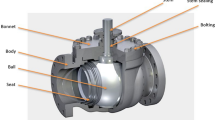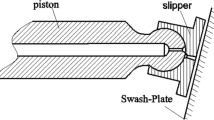Abstract
It is well known that static seals are usually designed to be used once. In this paper, we discuss the reusability of a type of static seal called the spring energized metal C ring, which is required to be reused 4–5 times without maintenance during the lifetime of the pump. A theoretical analysis based on the nonlinear finite element method and an experimental investigation of the reusability of the C ring are carried out. The effects of the elastic modulus of the ring material, the ring wall thickness, the amount of assembly interference between the spring and the C ring, the operating temperature and the compression ratio are discussed. The parameter S, which denotes the reaction force difference percentage, is determined to measure the reusability of the C ring. The results show that the ring wall thickness plays an important role in the reusability. Although the normal force of a thick wall decreases after the ring is reused eight times, the value is still higher than the first normal force of a thin wall. In contrast, the elastic modulus of the material has the lowest impact. Here, a pre-compression ratio of 18.2% not only produces a larger first normal force but also leads to a smaller reduction in the normal force when the ring is reused. A simulated experiment is carried out to investigate the influence of the coating of the C ring on its reusability. The results show that when plastic deformation occurs on the contact surface, the contact state of the C ring coating becomes a major factor that affects the seal performance. Aging treatment at high temperatures (250°C) reduces the binding force of the silver coating on the spring energized metal C ring, which leads to the deterioration in the reusability of the ring.
Similar content being viewed by others
References
Sanit-Gobain Seals. The high-performance sealing solutions experts. Granden Grove, CA USA, 2012
Gao Z, Li Y J, Suo S F, et al. Shut-down seal mechanism used in reactor coolant pump. China Patent, ZL201010168182.5, 2001-11-26
Gu, B Q, Li X H, Tian Z. Technology of Static Seal Design (in Chinese). Beijing: China Standard Press, 2004. 85–86
Duignan M T, Gerhardt D J, Whitney W T. Metal C ring window seal. Rev Sci Instrum, 1989, 60: 3537–3539
Xu Z S, Fan J, Xie Y Y. Introduction of modern technology of seal. Mod Manu Tech Equipment, 2010, 194: 7–9
Hao M M. Technology of Seals in Process Equipments (in Chinese). Beijing: China Petrochemical Press, 2010. 78–80
Liu B, Qiao G Y, Xu J Z, et al. FEM analysis on high-pressure static sealing of low-temperature liquid rocket engine. Struct Environ Eng, 2010, 37: 39–45
Sun F S. Application of auto-seal mechanism in ultra-high pressure working condition. Hydraulic Pneum, 1992, 4: 44–45
Cui X J. Research progress of metal seal technology and their sealing mechanism. China Petrol Machinery, 2011, 39(suppl): 102–104
Nitta I, Matsuzaki Y. Experimental study of the performance of static seals based on measurements of real contact area using thin polycarbonate films. J Tribol, 2010, 132: 022202
Fan P Z. Technology and manufacture process of the static seals used for space shuttle. Aerosp Process, 1999, 4: 11–16
Bayer R G. Wear of a C ring seal. Wear, 1981, 74: 339–351
Zhou K. Research on the performance of repeated use for spring energized metal C ring (in Chinese). Dissertation for the Master Degree. Beijing: Tsinghua University, 2012
Gu B Q, Chen Y, Zhu D S. Prediction of leakage rates through sealing connections with nonmetallic gaskets. Chin J Chem Eng, 2007, 15: 837–841
Sun J J, Gu B Q, Wei L, et al. Predicting seal life for contact mechanical seals (in Chinese). J Chem Ind Eng, 2008, 59: 3095–3100
Cai Y M, Zhang H, Zhu H. Finite elemental analysis of metal O ring. Petro-Chem Equipment Tech, 2008, 29: 60–63
Shi Z H, Yu J P, Zhou F G, et al. Quantitative gastight testing researches on hollow metal O-ring at room temperature. Pres Ves, 2003, 120: 16–18
Zhuang Z, Zhang F, Cen S. Nonlinear Finite Element Analysis and Examples of Abaqus (in Chinese). Beijing: Science Press, 2005
Liu Y, Suo S F, Wen Q F, et al. Shut-down seal rig. China Patent, ZL201110286929., 2014-4-16
Suo S F, li Y J, Huang W F, et al. The controlling system of shut-down seal system for HTR power plant. China Patent, ZL201110135-046.0, 2014-4-16
Author information
Authors and Affiliations
Corresponding author
Rights and permissions
About this article
Cite this article
Liu, Y., Zhou, K., Huang, W. et al. Numerical and experimental analysis of the reusability of spring energized metal C rings. Sci. China Technol. Sci. 57, 1670–1676 (2014). https://doi.org/10.1007/s11431-014-5584-3
Received:
Accepted:
Published:
Issue Date:
DOI: https://doi.org/10.1007/s11431-014-5584-3




